Introduction
Plants inside our homes, offices, or those used as part of a patio garden have been shown to create a relaxed environment, improving concentration and productivity while reducing stress and anxiety (Nieuwenhuis et al. 2014; Chang and Chen 2005; Evensen et al. 2015; Han 2009). Houseplants also improve indoor air quality by removing several volatile organic chemicals (VOCs) and particulate matter from the air (Kim et al. 2014). Indoor VOCs, commonly found in new furniture, home decorations, and many household products, include formaldehyde, benzene and 2-ethyl-1-hexanol, and many more detrimental to health. Various studies have reported that houseplants can remove VOCs from indoor air (Wood et al. 2006; Liu et al. 2007). A 9-week study showed that the presence of indoor plants decreased the VOCs and particulate matter by 70% and 30%, respectively (Pegas et al. 2012). Overall, houseplants are an efficient, low-cost, and sustainable way to improve air quality and well-being.
While houseplants are safe to grow and provide many benefits, some can be toxic if ingested accidentally, which could be a concern for those with pets or small children. This publication is intended to inform homeowners, home gardeners, pest management professionals, and other plant enthusiasts of some of the most common poisonous plant species used as houseplants in Florida. This publication focuses on species which are potentially harmful if ingested, so that readers relocate these plants to other inaccessible (for small children or pets) areas of the home to prevent accidental exposure if it is a concern. It should be noted that while photos are provided of each species, there are many variations of each plant described which could have different foliage color, variegations, leaf-shape variations, or flower colors.
Dumbcane (Dieffenbachia spp.)
Other Common Names
Dumbcane, leopard lily, spotted dumbcane, variable dieffenbachia
Family
Araceae
Life Span
Perennial
Biology
Dumbcane is a popular houseplant that naturally grows in tropical regions (Figure 1). The leaves of dumbcane are broad, and paddle-shaped with distinctive white spots and flecks. The leaves are green in color with spots of cream, yellow, or white making it appealing as an indoor plant (Figure 2). The stems, which are fleshy and sturdy, can grow up to 6 to 10 feet tall in the wild but remain shorter in cultivation. The plant may flower indoors and in the wild, where the flowers are small and surrounded by a large, pale, light green spathe. Dumbcane grows best in medium to partial shade and prefers temperatures between 60°F-80℉.

Credit: Yuvraj Khamare, UF/IFAS
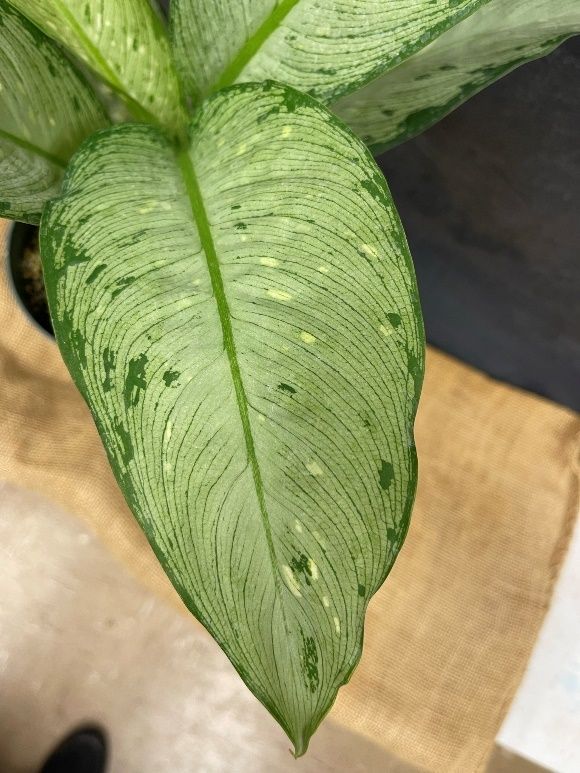
Credit: Yuvraj Khamare, UF/IFAS
Toxicity
The sap of dumbcane is poisonous and causes a painful, swollen mouth with excessive saliva. The nickname dumbcane refers to the adverse reaction of the sap, resulting in the loss of a person’s ability to speak due to tongue swelling, irritation, and excessive salivation. The main toxic agent present in the plant is calcium oxalate crystals called raphides. Other compounds such as a proteolytic enzyme called “dumbcain,” cyanogenic glycoside, asparagine, and protoanemonin are also present in the plant which can cause smooth muscle contraction and soft tissue edema (Arditti and Rodriguez 1982). Ingestion of a small piece of the stem can cause severe irritation in the mouth, as well as a burning sensation in the mouth, throat, and even vocal cords (Pohl 1961). Other symptoms include difficulty speaking, swallowing, skin irritation, nausea, vomiting, and diarrhea.
The Swiss Cheese Plant (Monstera deliciosa)
Other Common Names
Fruit salad plant, fruit salad tree, ceriman, cutleaf philodendron, hurricane plant, Mexican breadfruit
Family
Araceae
Life Span
Perennial
Biology
The Swiss cheese plant is commonly used to decorate houses and offices in Florida. It is a woody, perennial, climbing vine in the Arum family. The mature leaves of the plant are large, glossy, and dark green, growing up to 10 to35 inches long. Leaves are heart-shaped and distinctly cut with many internal holes. The common name Swiss cheese plant refers to the presence of holes in leaves like the holes in Swiss-type cheeses; although, the young leaves are smaller and have almost no lobes or holes. The plant has thick stems and long, cord-like aerial roots that can grow up to 66 feet high in an outdoor environment (Figure 3). The flowers of the plant are a fleshy erect spadix (spike-like structure) surrounded by a white spathe. The flowers are creamy white and large with a length of 8 to 12 inches. The flowers are self-pollinating and can produce an edible fruit. The fruit looks like an ear of corn covered with hexagonal shaped green scales (Figure 4). However, the plant rarely flowers or fruits indoors. Outdoors Monstera deliciosa can pose a high invasion risk based on the IFAS Assessment of Non-Native plants and is not recommended by IFAS (https://assessment.ifas.ufl.edu/assessments/monstera-deliciosa/).
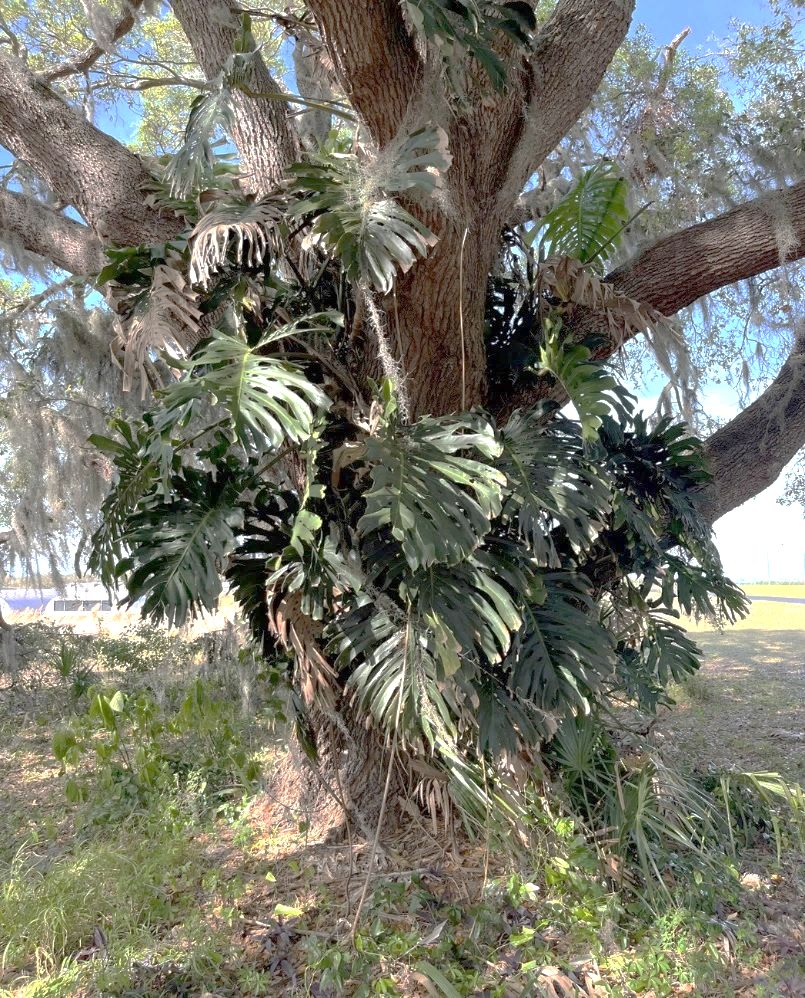
Credit: Yuvraj Khamare, UF/IFAS
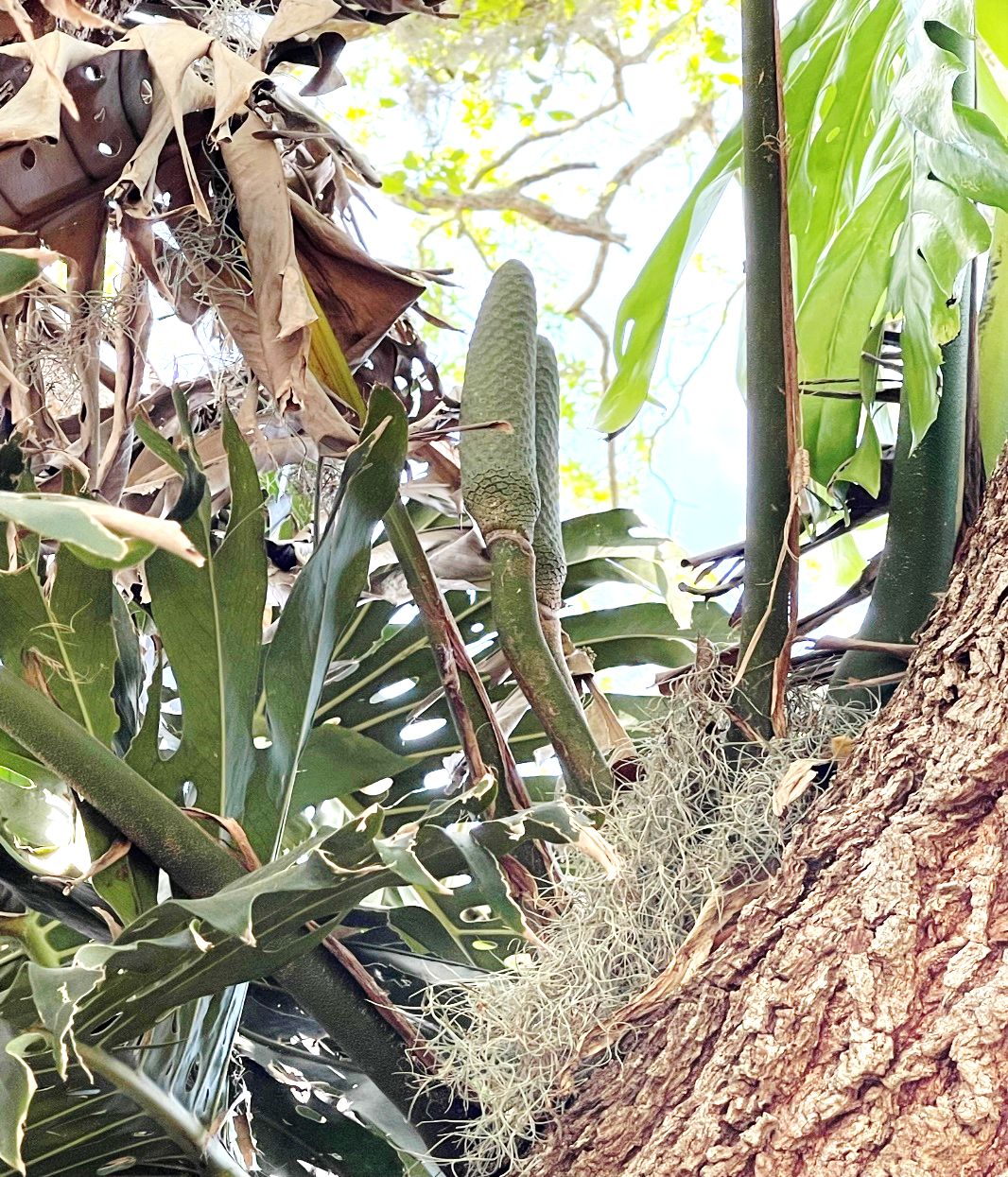
Credit: Yuvraj Khamare, UF/IFAS
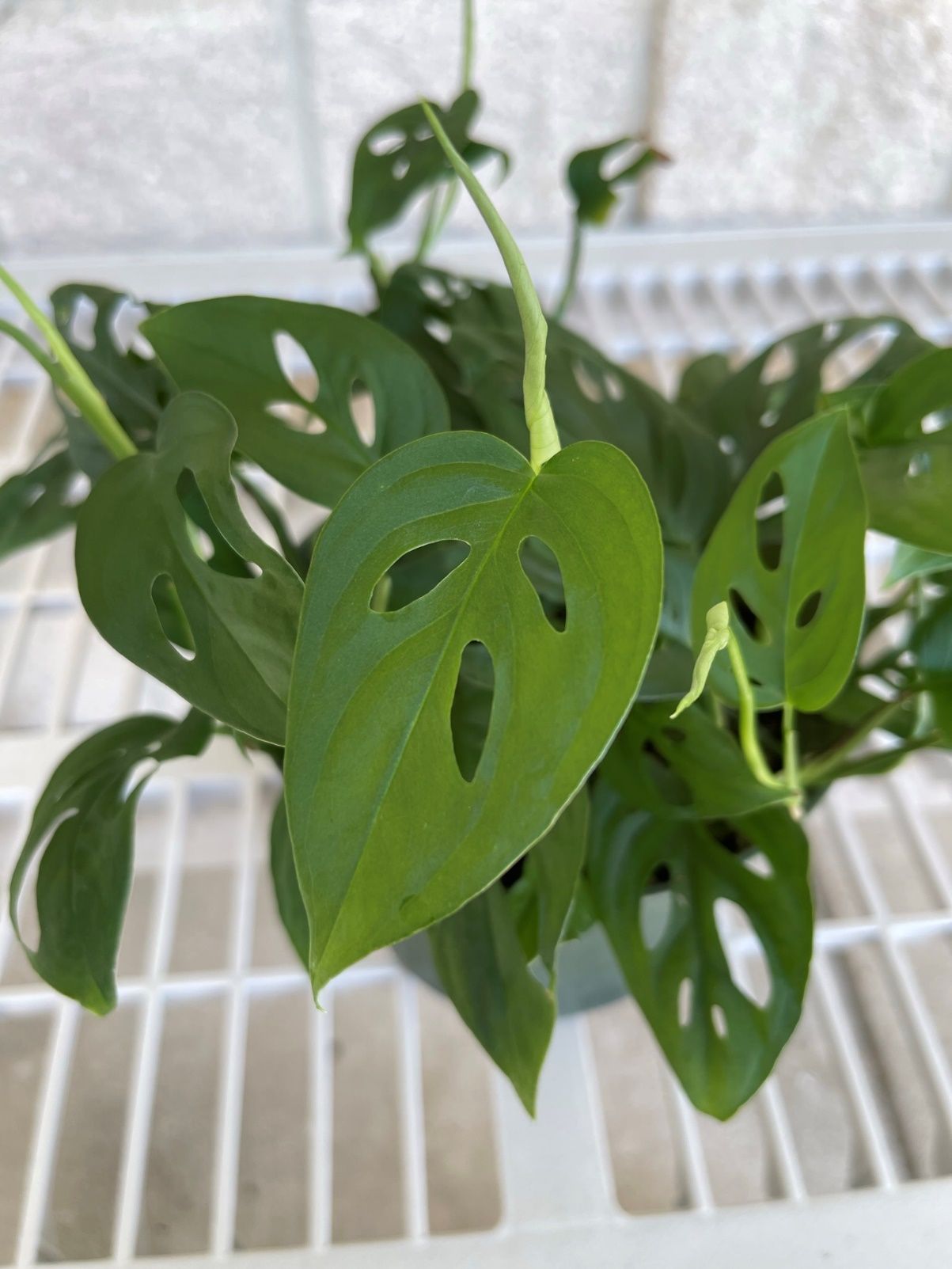
Credit: Yuvraj Khamare, UF/IFAS
Toxicity
All Monstera species and their plant parts are toxic to dogs, cats, and humans. While it has edible fruit, the unripe fruit is still toxic. The main toxic agent present in the plant is needle-like, insoluble calcium oxalate crystals. The sap of the plant is dangerous, especially for pets and children, as it can cause irritation and inflammation of the mouth, throat, eyes, and digestive tract. The needle-shaped calcium oxalate crystals can penetrate the mucous membranes of the mouth and cause burning and irritation (Engelbrecht and Cilliers 2012). Adanson’s monstera (Monstera adansonii) is another common houseplant that is toxic to cats, dogs, and humans (Figure 5).
Heartleaf Philodendron (Philodendron hederaceum)
Other Common Names
Parlor Ivy, philodendron, philodendron scandens, sweetheart plant
Family
Araceae
Life Span
Perennial
Biology
Heartleaf philodendron is a climbing, evergreen perennial vine that can grow up to 10 to 15 feet tall in its natural habitat. The leaves are glossy, heart shaped, and dark green, growing up to 12 inches long (Figure 6). The stems of the plant climbs or trails on a pot or any other support. It prefers to grow in medium light at average indoor temperatures, making it a great choice as a houseplant. The flowers are rarely seen in cultivation, but in the wild they are small and white. They have an arum-like shape with smaller flowers, surrounded by a yellow-green spathe. The fruit are white to orange in color and cluster around a spike-like structure.

Credit: Yuvraj Khamare, UF/IFAS
Toxicity
Toxic substances such as proteolytic enzymes and calcium oxalate are present in the sap of heartleaf philodendron (Severino 2009). All parts of the plant contain needle-like calcium oxalate crystals. The symptoms range from oral irritation, pain, and swelling of the mouth, tongue, and lips. It can also severely affect the digestive tract, skin, kidneys, and lungs. It can result in lethal poisoning in cats.
Arrowhead (Syngonium podophyllum)
Other Common Names
African evergreen, American evergreen, arrowhead vine, green-gold naphthysis
Family
Araceae
Life Span
Perennial
Biology
Arrowhead refers to the arrow-shaped leaves (Figure 7) that can grow up to 12 inches long. In cultivation, the leaves vary in shades of green with variegation, while in the wild they are mostly light green without any white spots. The young plant has a shrubby habit that takes on a vine-like habit once matured. In its natural habitat, it can climb over a 3- to 6-foot-tall tree. In general, the leaves are dark green on top and pale green on the bottom. The mature plants have a 15- to 24-inch-long leafstalk and three to 12 leaflets of varying sizes, with the larger one in the center (Morgan, Overholt, and Langeland 2004). The flowers are small, green-to-greenish white enclosed in a creamy white-to-green spathe. The plant rarely flowers or fruits indoors. Arrowhead vine has become highly invasive in Florida, escaping cultivation, and is now considered a Category I invasive by the Florida Invasive Species Council (https://floridainvasivespecies.org/) (Morgan, Overholt, and Langeland 2004). Thus, Syngonium is not recommended for use in Florida by UF/IFAS.
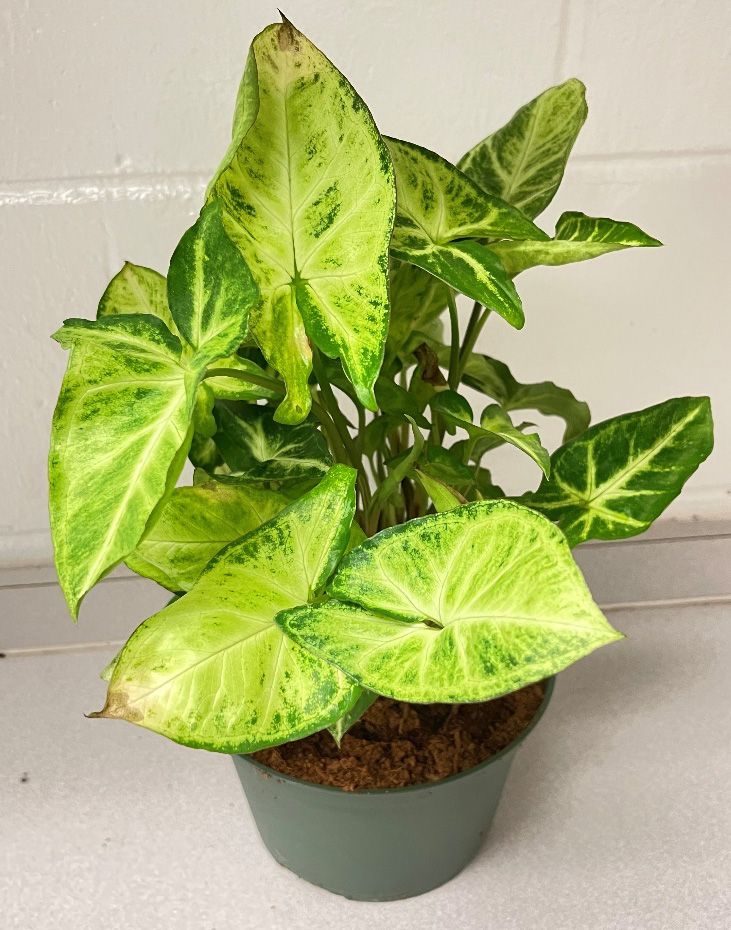
Credit: Yuvraj Khamare, UF/IFAS
Toxicity
All parts of the plant contain calcium oxalate crystals. If ingested, it can cause severe mouth pain and swelling. The plant sap can also cause severe skin burning and eye damage. Other symptoms such as gastric irritation, salivation, burning sensation of lips, mouth, tongue, and throat, and difficulty in speaking can also occur.
ZZ Plant (Zamioculcas zamiifolia)
Other Common Names
Aroid palm, aroid plant, emerald palm, eternity plant, Zanzibar gem, zuzu plant
Family
Araceae
Life Span
Perennial
Biology
ZZ plant is the only species in the Zamioculcas genus. It is a tropical perennial plant native to Africa. The plant has pinnately compound leaves (feather-like) that are smooth, glossy, dark green, and up to 6 inches long and 2 inches wide (Figure 8). Each leaf has a pair of six to eight glossy green leaflets. The stems start from a thick and fleshy rhizome and taper towards the top (Figure 9). The flowers are small, bright yellow to brown, 2 to 3 inches long, and partially among the leaf bases.
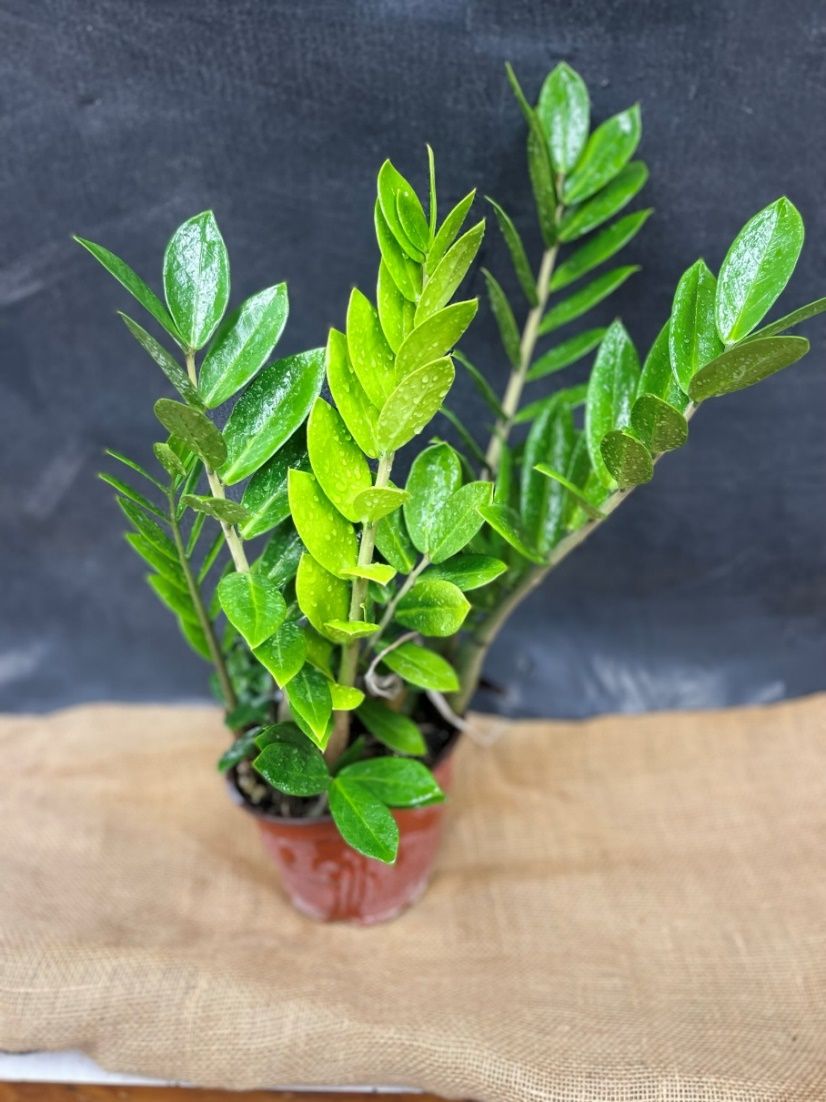
Credit: Yuvraj Khamare, UF/IFAS
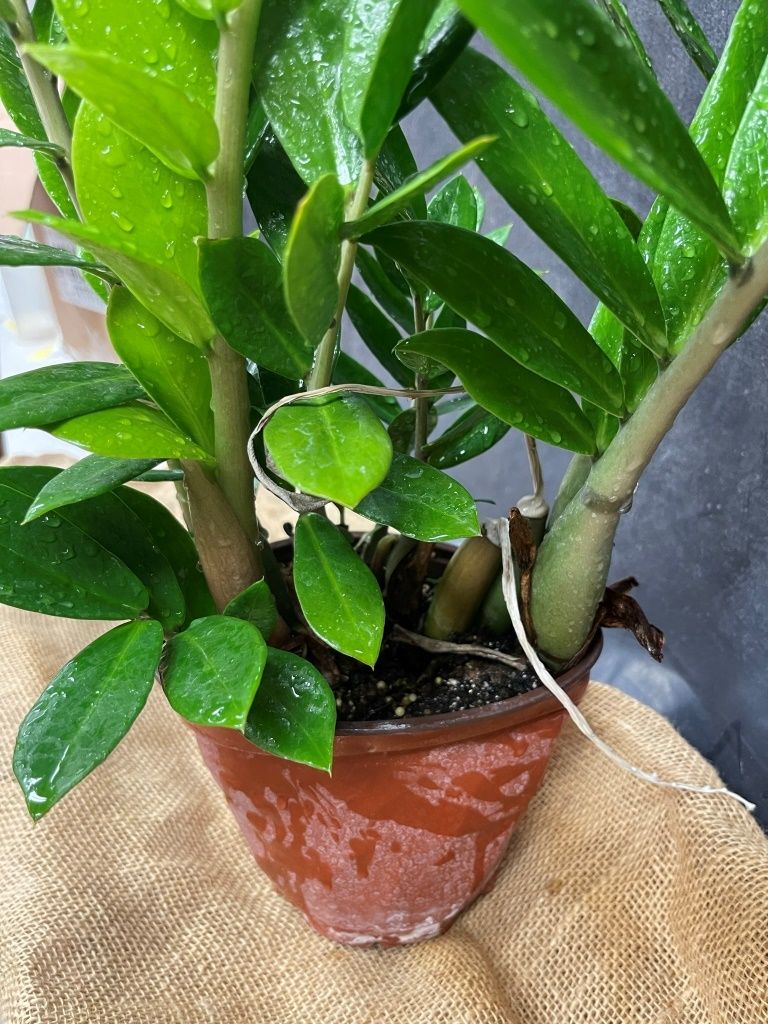
Credit: Yuvraj Khamare, UF/IFAS
Toxicity
Like many other species in the Araceae family, the ZZ plant also contains high levels of calcium oxalates. If chewed or ingested, it can result in immediate pain or a burning sensation in the lips, mouth, tongue, or throat. Other symptoms such as diarrhea and vomiting can also be observed.
English Ivy (Hedera helix)
Other Common Names
Algerian ivy, common ivy branching ivy, glacier ivy, needlepoint ivy
Family
Araliaceae
Life Span
Perennial
Biology
English ivy is a vigorous, fast-growing, woody perennial vine that can climb up to 100 feet high on suitable surfaces in the wild (Metcalfe 2005). It can also trail as a ground cover in the absence of climbing surfaces. The leaves of the young plant are palm-shaped with three- to five-lobed, dark green leaves on stems with adventitious roots that can climb surfaces and spread (Figure 10). This plant grows vigorously, has become invasive in many parts of the United States, and poses a high invasion risk in Florida based on the UF/IFAS assessment (https://assessment.ifas.ufl.edu/assessments/hedera-helix/). The leaves of a mature plant are lobeless, oval-shaped with narrow ends, and dark green when on stems with no roots that climb or spread. The matured plant produces round, umbrella-like clusters of white-to-green flowers with five sepals (Metcalfe 2005). The fruits are blue-to-black berries, 0.2 to 0.3 inch in diameter, and ripen in late winter.
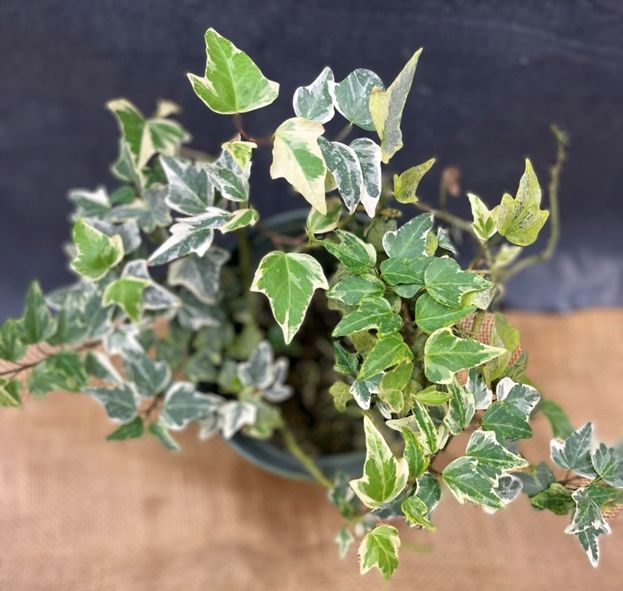
Credit: Yuvraj Khamare, UF/IFAS
Toxicity
All species of Hedera contain toxic and irritant compounds in all parts of the plant. The toxic agents are found highly concentrated in young leaves and fruit. The toxic compounds present in the plant consist of terepenoid saponins, rutin, caffeic acid, chlorogenic acid, and emetine (Descotes 1996). Contact with sap can result in severe skin irritation, redness, itching, and blisters. Ingestion of leaves can cause abdominal pain, diarrhea, hallucinations, rash, fever, and hypersalivation. The berries are also toxic and can cause a burning sensation in the mouth and throat (Figure 11).

Credit: Jan Samanek, Phytosanitary Administration, Bugwood.org
Pothos (Epipremnum aureum)
Other Common Names
Devil's ivy, devil's vine, golden pothos, ivy arum, marble queen
Family
Aureum
Life Span
Perennial
Biology
Pothos is a popular indoor plant since it is easy to grow and can remove indoor pollutants such as formaldehyde and benzene in a sealed room (Xu, Wang, and Hou 2011). It is a perennial climbing vine that can climb up to 40 feet or more in its native habitat. The leaves of the young plant are heart shaped, green, bright, glossy, and variegated with yellow or white spots (Figure 12). The leaves of young plants are about 4 inches long whereas the leaves of matured plants can grow up to 30 inches long with deep lobes. Pothos are described as shy-flowering plants, meaning it fails to flower either in the wild or in cultivation (Hung et al. 2016). Similar to other species in this publication, both Epipremnum pinnatum and Epipremnum aureum pose a high risk of becoming invasive in Florida based on the IFAS Assessment and are not recommended by UF/IFAS with Epipremnum aureum being classified as a FISC category II invasive (https://floridainvasivespecies.org/).
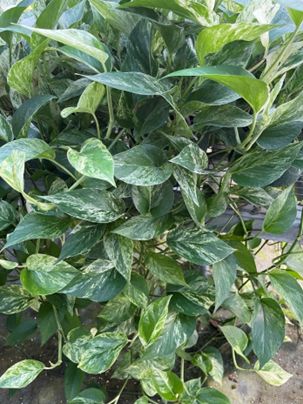
Credit: Yuvraj Khamare, UF/IFAS
Toxicity
The main toxic compound present in pothos is insoluble calcium oxalates. The plant is listed as toxic to cats and dogs by the American Society for the Prevention of Cruelty to Animals (ASPCA). All parts of the plant are poisonous. Symptoms include oral irritation, vomiting, pain and mouth swelling, difficulty in swallowing, skin irritation, and diarrhea (Meshram and Srivastava 2015).
Peace Lily (Spathiphyllum spp.)
Other Common Names
Mauna Loa peace lily, spathe flower, white sails
Family
Araceae
Life Span
Perennial
Biology
Spathiphyllum is a genus with more than 40 species in the Araceae family that are all commonly known as peace lily. The peace lily is a clumping, evergreen perennial that can grow up to 6 feet tall, but typically grows around 2 to 3 feet indoors (Figure 13). It has dark green, glossy leaves that are oval-shaped and pointed at the tip. The leaves grow directly from the soil, and the plant produces long stems that emerge from the center of the plant and bear flowers. The flowers are distinctive, usually white, although some varieties may have pink or yellow blooms. The flowers are composed of a central spadix, which is surrounded by a white, leaf-like sheath called a spathe (Figure 14).

Credit: Yuvraj Khamare, UF/IFAS
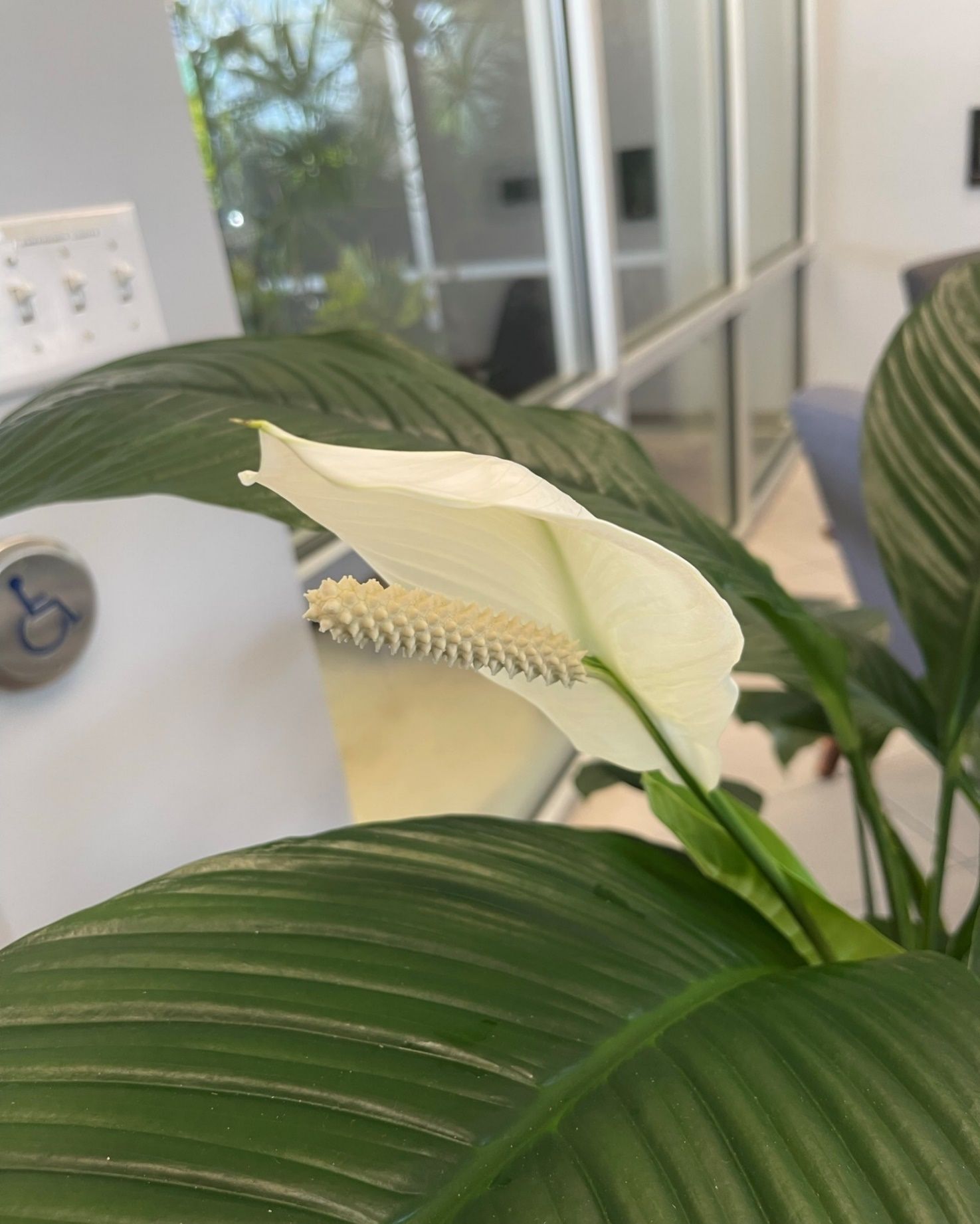
Credit: Yuvraj Khamare, UF/IFAS
Toxicity
The peace lily contains calcium oxalate crystals, which can cause irritation and swelling of the mouth, tongue, and throat if ingested (Siroka 2023). Other symptoms include excessive drooling, diarrhea, lethargy, and nausea. In severe cases, peace lily ingestion can lead to more serious symptoms, such as breathing difficulties, and heart palpitations.
Easter Lily (Lilium longiflorum)
Other Common Names
Wild lily, trumpet lily
Family
Liliaceae
Life Span
Perennial
Biology
Easter lily is commonly used in cut flower arrangements. Easter lily leaves are long, lanceolate, and glossy green. They range in size from 8 to 12 inches long and 2 to 3 inches wide. They have a smooth, waxy texture and are arranged alternately along the stem. The stem is typically erect and ranges from 1 to 2 feet in height. It is thick and fleshy with a light-green color. It has large, fragrant, trumpet-shaped, white flowers (Figure 15). The flowers typically bloom in the spring or early summer.
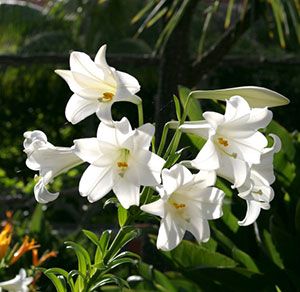
Credit: Gardening Solutions, UF/IFAS
Toxicity
All parts of the plant are toxic to cats (Severino 2009) and can cause serious health problems, like acute renal failure, if ingested. Cats are extremely sensitive to the plant (and other lily species), and ingestion of just two leaves or parts of a flower have caused death. Signs of toxicity are typically observed within 12 hours after ingestion followed by kidney failure in 2 to 3 days (Milewski and Khan 2006). It can cause other serious health issues in cats, including vomiting, diarrhea, dehydration, kidney failure. In general, many species of the genus Lilium and Hemerocallis (day lilies) are considered potentially toxic to cats (Fitzgerald 2010).
Corn Plant (Dracaena fragrans)
Other Common Names
Cornstalk plant, dragon tree, ribbon plant, striped dracaena, striped dragon palm
Family
Asparagaceae
Life Span
Perennial
Biology
The corn plant is a broadleaf evergreen, perennial shrub, native to tropical Africa. The plant resembles the tall, unbranched stem of a corn stalk, giving it the common name corn plant. It can grow up to 20 feet or more in its native habitat and up to 4 to 6 feet tall as a container plant. The leaves are long, narrow, and lance-shaped, growing in an upward and outward direction from a central stem. The leaves are dark green and may have yellow or white stripes along the margins (Figure 16). The flowers are small, white, and fragrant, clustered on a stalk that emerges from the center of the plant (Figure 17). The flowers give way to berries that are orange red and contain seeds; however, flowering is a rare occurrence in indoor settings, as these plants need very specific environmental conditions to bloom.
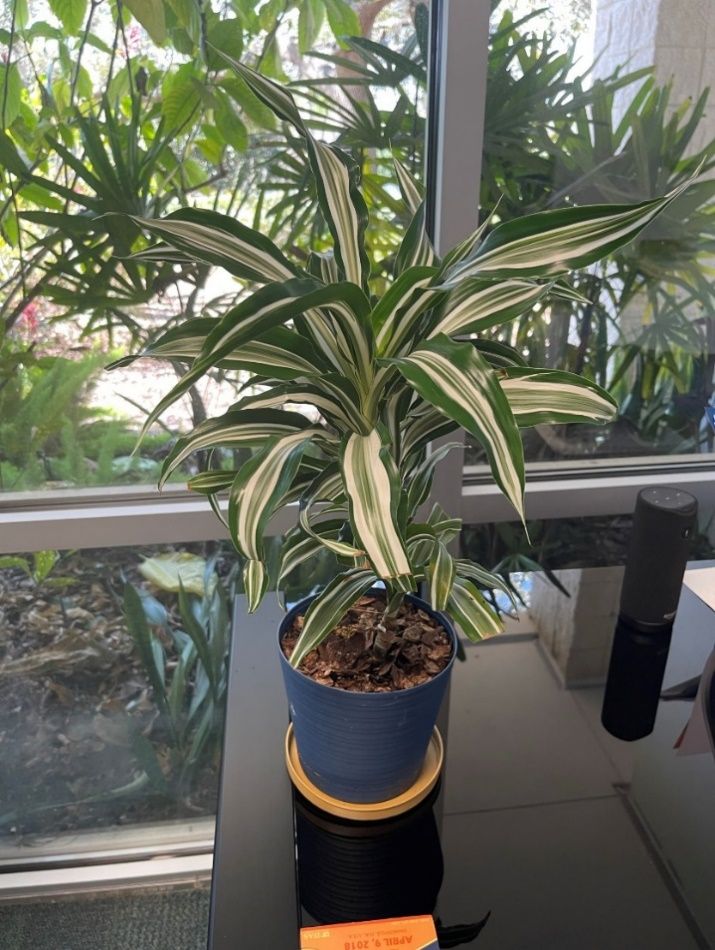
Credit: Yuvraj Khamare, UF/IFAS
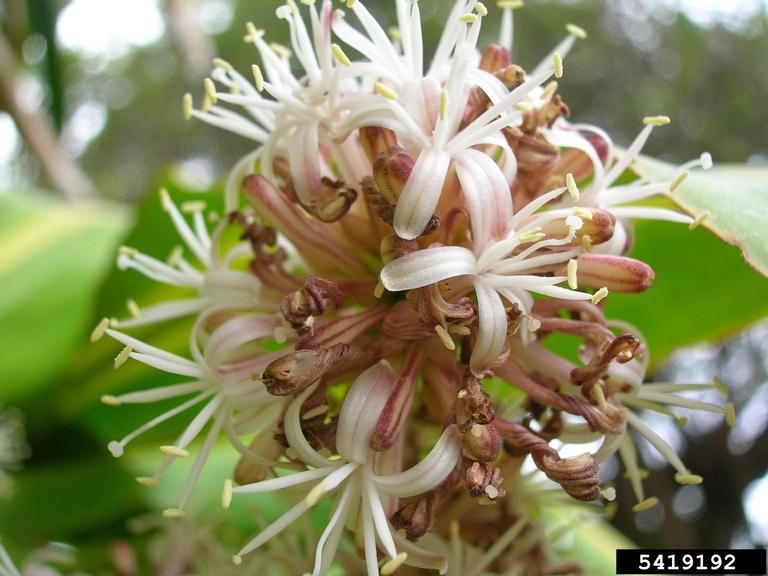
Credit: Forest and Kim Starr, Starr Environmental, Bugwood.org
Toxicity
The plant contains saponins, which can cause gastrointestinal irritation, vomiting, and diarrhea if consumed (Siroka 2023). In some cases, it can also cause drooling, lethargy, and loss of appetite. In severe cases, it can lead to kidney failure.
Conclusions
It should be noted that just because a plant may be toxic if ingested does not mean you should avoid owning one. Plant enthusiasts should be aware of these and other potentially toxic plants if they have pets with a tendency to chew on plant material or young children who could put parts of these or other toxic plants in their mouths. If you suspect that a person or pet has been poisoned, contact Poison Control or your medical professional immediately.
References
Arditti, J., and E. Rodriguez. 1982. “Dieffenbachia: Uses, Abuses, and Toxic Constituents: A Review.” Journal of Ethnopharmacology. 5(3): 293-302. https://doi.org/10.1016/0378-8741(82)90015-0
Chang, C. Y., and P. K. Chen. 2005. “Human Response to Window Views and Indoor Plants in the Workplace.” HortScience. 40(5): 1354-1359. https://doi.org/10.21273/HORTSCI.40.5.1354
Descotes, J., ed. 1996. Human Toxicology. The Netherlands: Elsevier Science.
Engelbrecht, A., and A. M. Cilliers. 2012. “Poisonous Plants: More About…Emergency Medicine.” CME: Your SA Journal of CPD. 30(11): 420-423. https://hdl.handle.net/10520/EJC128862
Evensen, K. H., R. K. Raanaas, C. M. Hagerhall, M. Johansson, and G. G. Patil. 2015. “Restorative Elements at the Computer Workstation: A Comparison of Live Plants and Inanimate Objects with and Without Window View.” Environment and Behavior. 47(3): 288-303. https://doi.org/10.1177/0013916513499584
Fitzgerald, K. T. 2010. “Lily Toxicity in the Cat.” Topics in Companion Animal Medicine. 25(4): 213-217. https://doi.org/10.1053/j.tcam.2010.09.006
Han, K. T. 2009. “Influence of Limitedly Visible Leafy Indoor Plants on the Psychology, Behavior, and Health of Students at a Junior High School in Taiwan.” Environment and Behavior. 41(5): 658-692. https://doi.org/10.1177/0013916508314476
Hung, C. Y., J. Qiu, Y. H. Sun, J. Chen, F. S. Kittur, R. J. Henny, G. Jin, L. Fan, and J. Xie. 2016. “Gibberellin deficiency is responsible for shy-flowering nature of Epipremnum aureum.” Scientific Reports. 6(1): 1-11. https://doi.org/10.1038/srep28598
Kim, H. H., J. Y. Yang, J. Y. Lee, J. W. Park, K. J. Kim, B. S. Lim, G. W. Lee, S. E. Lee, D. C. Shin, and Y. W. Lim. 2014. “House-Plant Placement for Indoor Air Purification and Health Benefits on Asthmatics.”. Environmental Analysis Health and Toxicology. 29. https://doi.org/10.5620/eht.e2014014
Liu, Y. J., Y. J. Mu, Y. G. Zhu, H. Ding, and N. C. Arens. 2007. “Which ornamental plant species effectively remove benzene from indoor air?” Atmospheric Environment. 41(3): 650-654. https://doi.org/10.1016/j.atmosenv.2006.08.001
Meshram, A., and N. Srivastava. 2015. “Epipremnum aureum (Jade pothos): A Multipurpose Plant with its Medicinal and Pharmacological Properties.” Journal of Critical Reviews. 2(2): 21-5.
Metcalfe, D. J. 2005. “Hedera helix L.” Journal of Ecology. 93(3): 632-648. https://doi.org/10.1111/j.1365-2745.2005.01021.x
Milewski, L.M., and S. A. Khan. 2006. “An Overview of Potentially Life-Threatening Poisonous Plants in Dogs and Cats.” Journal of Veterinary Emergency and Critical Care. 16(1): 25-33. https://doi.org/10.1111/j.1476-4431.2005.00151.x
Morgan, E. C., W. A. Overholt, and K. A. Langeland. 2004. “Wildland Weeds: Arrowhead Vine, Syngonium podophyllum: ENY-715/IN530, 9/2004.” EDIS 2004 (15). https://doi.org/10.32473/edis-in530-2004
Nieuwenhuis, M., C. Knight, T. Postmes, and S. A. Haslam. 2014. “The Relative Benefits of Green Versus Lead Office Space: Three Field Experiments.” Journal of Experimental Psychology: Applied. 20(3): 199. https://doi.org/10.1037/xap0000024
Pegas, P. N., C. A. Alves, T. Nunes, E. F. Bate-Epey, M. Evtyugina, and C. A. Pio. 2012. “Could houseplants improve indoor air quality in schools?” Journal of Toxicology and Environmental Health, Part A. 75(22-23): 1371-1380. https://doi.org/10.1080/15287394.2012.721169
Pohl, R.W., 1961. “Poisoning by Dieffenbachia.” JAMA. 177(11): 812-813. https://doi.org/10.1001/jama.1961.03040370074021
Severino, L., 2009. “Toxic Plants and Companion Animals.” CABI Reviews. 1-6. https://doi.org/10.1079/PAVSNNR20094008
Siroka, Z. 2023. “Toxicity of House Plants to Pet Animals.” Toxins. 15(5): 346. https://doi.org/10.3390/toxins15050346
Wood, R. A., M. D. Burchett, R. Alquezar, R. L. Orwell, J. Tarran, and F. Torpy. 2006. “The potted-plant microcosm substantially reduces indoor air VOC pollution: I. Office Field-study.” Water, Air, and Soil Pollution. 175: 163-180. https://doi.org/10.1007/s11270-006-9124-z
Xu, Z., L. Wang, and H. Hou. 2011. “Formaldehyde Removal by Potted Plant-soil Systems.” Journal of Hazardous Materials. 192(1): 314-318. https://doi.org/10.1016/j.jhazmat.2011.05.020